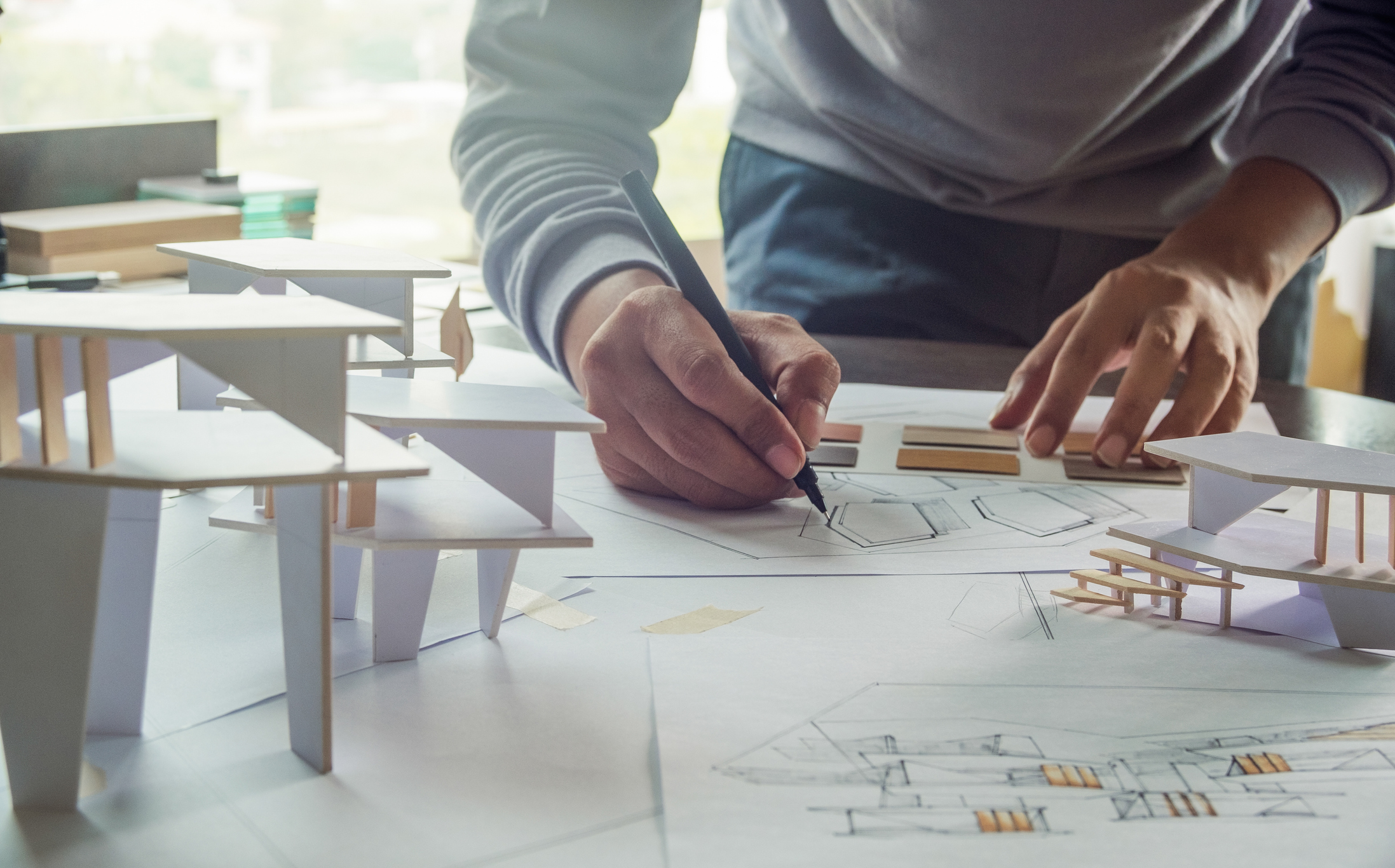Architect Advice on Utilizing Small Urban Spaces
Architect Advice on Utilizing Small Urban Spaces
Blog Article
Comprehending the Diverse Job Paths Available for Aspiring Architect
As a hopeful Architect, you have a world of occupation courses awaiting you. Each course uses one-of-a-kind obstacles and possibilities to apply your creative thinking and technological expertise. Whether you're attracted to conventional style or the nuances of sustainable layout, there's a particular niche that lines up with your rate of interests. Recognizing these varied choices can form your specialist trip, however which direction will you select to check out first?
Traditional Style: Creating Frameworks and structures
Typical design concentrates on developing structures and structures that mix functionality with visual charm. Your layouts can reflect social heritage, showcasing local practices while meeting contemporary demands.
You'll create skills in composing, model-making, and site evaluation, permitting you to imagine and connect your concepts successfully. Involving with clients, you'll require to recognize their vision and translate it right into possible styles.
In addition, building codes and sustainability methods are important in your work, guaranteeing your frameworks are eco friendly and safe. As you expand in your job, you'll find opportunities in property, commercial, and even remediation jobs, each offering distinct obstacles. Welcoming traditional architecture leads the way for a meeting career that admires the past while shaping the future.
Urban Preparation: Forming Neighborhoods and Public Spaces
As a hopeful Architect, you can play a vital function as a metropolitan planner, changing how communities work and engage. By utilizing community engagement strategies, you'll assure that homeowners have a voice in forming their atmosphere. Plus, incorporating lasting style principles will aid develop areas that not only fulfill today's demands however also protect the future.
Function of Urban Planners
While many might assume of engineers as the single visionaries behind buildings, metropolitan organizers play an important function in shaping the more comprehensive landscape of areas and public spaces. By collaborating with different stakeholders, you'll assist make parks, transport systems, and residential areas that promote social interaction and availability. Your proficiency in spatial design and neighborhood dynamics allows you to visualize future growth while protecting cultural heritage.
Neighborhood Involvement Approaches
Effective area interaction strategies are essential for city planners to ensure that the voices of residents are listened to and valued in the preparation process. To cultivate meaningful discussion, you should focus on open online forums and workshops where neighborhood members can reveal their concepts and issues. By actively integrating and paying attention responses, you'll create spaces that show the neighborhood's demands, ultimately leading to more sustainable and successful metropolitan atmospheres.
Lasting Layout Concepts
When designing urban spaces, integrating sustainable style concepts is crucial for creating environments that flourish both environmentally and socially. You must begin by concentrating on power performance, making use of products that lower waste and advertise recycling. Take into consideration incorporating environment-friendly rooms, like yards and parks, to boost biodiversity and boost air top quality. Advertising walkability and public transport can reduce reliance on automobiles, fostering a much healthier area.
Designing with water preservation in mind is likewise essential-- think concerning rain yards and absorptive surface areas to handle stormwater. Entailing community participants during the preparation process guarantees that the rooms you create fulfill their requirements and urge social interaction. By embracing these concepts, you'll add to lively, sustainable metropolitan landscapes that benefit everybody.

Landscape Design: Developing Sustainable Outside Settings
As you explore landscape design, you'll uncover important layout principles that create attractive and functional outside rooms. Lasting practices play a crucial duty in ensuring these atmospheres grow while reducing environmental influence. Plus, you'll find a range of occupation possibilities that permit you to make a real difference in how people communicate with nature.
Design Principles in Landscape
Understanding style concepts in landscape architecture is essential for producing lasting outside atmospheres that integrate with nature. You'll require to consider aspects like balance, scale, and proportion to ensure your designs feel cohesive and welcoming. Including indigenous plants not just improves biodiversity but also reduces water usage, making your landscape resistant. Consider the flow of space and just how individuals communicate with it; pathways and seating locations must invite expedition and leisure. Furthermore, focus on seasonal changes, making with materials that complement the environments year-round (Architect). By prioritizing sustainability and looks, you can produce outdoor spaces that improve the community and advertise wellness. Embracing these concepts will establish a strong foundation for read review your occupation in landscape design.
Lasting Practices Overview
Lasting methods in landscape architecture not just concentrate on appearances however also focus on environmental health and source conservation. You can design rooms that promote dirt health and wellness, such as practicing and making use of organic products permaculture principles. Ultimately, these methods guarantee your layouts benefit both individuals and the environment for years to come.
Job Opportunities Exploration
With a strong foundation in lasting techniques, landscape style offers a variety of career paths that enable you to make a significant influence on the environment. Urban planners typically team up with landscape architects to create eco-friendly rooms in city setups, enhancing city livability. If you're passionate about education and learning, take into consideration coming to be a landscape architecture teacher, inspiring future generations.
Sustainable Style: Concentrating On Eco-Friendly Practices
As you discover your job in style, accepting green methods can set you apart in an affordable area. Sustainable layout concentrates on producing buildings that reduce environmental impact while boosting owner wellness. By incorporating renewable products, energy-efficient systems, and sustainable structure techniques, you'll add to a greener future.
Begin by gaining expertise of eco-friendly certifications like LEED or BREEAM, which can strengthen your qualifications. Consider exactly how natural light, air flow, and thermal effectiveness can maximize style. Collaborate with engineers and ecological specialists to innovate options that reduce waste and preserve resources.
Do not forget the relevance of community participation-- appealing neighborhood stakeholders can influence designs that balance with the environment. As clients significantly prioritize sustainability, your proficiency in eco-friendly methods will certainly not only bring in projects however also meet your interest for responsible design. Welcome this critical aspect of the occupation, and see your career flourish.
Historic Conservation: Safeguarding and Bring Back Cultural Heritage
While you commence on your building journey, take into consideration the crucial role of historic preservation in keeping our cultural heritage. This field concentrates on the security and remediation of significant buildings, sites, and structures that tell the stories of our past. By engaging in historical conservation, you'll assist secure the building heritage that forms neighborhood identification.
As a historical conservation Architect, you'll evaluate historic significance and examine the condition of frameworks. You'll function closely with chroniclers and preservationists to assure genuine repair methods are utilized. This profession course allows you to mix creativity with study, allowing you to design solutions that value original materials and craftsmanship.
Your work not just adds to sustainability by recycling existing structures but additionally cultivates a sense of satisfaction within communities. Embracing this course will help you become a guardian of background, protecting the tales and visual appeals that enrich our lives.
Interior Architecture: Enhancing Indoor Spaces
Historic preservation and indoor style both share a dedication to boosting the developed atmosphere, however they focus on different elements. While historical preservation stresses keeping a structure's historic and cultural worth, indoor design absolutely nos Learn More in on optimizing interior areas for capability and looks.
As a hopeful Architect, you'll locate that indoor design permits you to blend creative thinking with technical abilities. You'll make rooms that not only look excellent yet also promote comfort and efficiency. This area entails recognizing exactly how light, shade, and products interact within an area, influencing mood and usability.
You'll work with different jobs, from residential homes to commercial workplaces, making sure that each atmosphere satisfies the requirements of its passengers. By focusing on user experience, you can change insides into motivating and functional areas, making a substantial impact on how individuals connect with their surroundings. Accept the possibility to enhance indoor settings and form the method people live and work.
Industrial Layout: Merging Capability With Appearances
Commercial style plays a necessary duty in developing items that effortlessly mix aesthetic appeals with functionality, making certain that what you make use of everyday is not only visually attractive yet additionally practical. As an aspiring Architect, you can involve yourself in this field, concentrating on designing whatever from furniture to consumer electronics. Your job involves recognizing user requirements, materials, and producing procedures, allowing you to create ingenious options click here now that boost daily experiences.
In commercial design, you'll usually team up with marketing professionals, engineers, and producers, making certain that your styles are not only stunning but additionally feasible. This career path provides a dynamic atmosphere where imagination meets functionality, making it a satisfying selection for architects interested in forming the items of tomorrow.
Regularly Asked Concerns
What Educational Credentials Do I Need to End Up Being an Architect?
To become a designer, you'll require an expert level in architecture, normally a Bachelor's or Master's. Additionally, you'll need to finish a teaching fellowship and pass the Architect Registration Exam to exercise legally.
Exist Qualification Demands for Various Building Career Paths?
Yes, there're certification needs for different building paths. Architect. You'll need to pass examinations, complete teaching fellowships, and often seek specialized training, depending on your chosen emphasis, like landscape design, urban layout, or historical conservation
What Software Program Abilities Are Crucial for Designers Today?

How Can I Gain Practical Experience While Studying Design?
You can obtain useful experience by interning at building companies, joining design competitions, volunteering for area projects, or collaborating with schoolmates on real-world tasks. These possibilities boost your abilities and develop beneficial connections in the sector.
What Task Opportunities Exist Outdoors Conventional Architecture Firms?
You can discover different job chances outside traditional design companies, like urban planning, interior decoration, landscape style, building and construction administration, property advancement, or even functions in sustainability consulting. Each offers special obstacles and benefits.
Whether you're attracted to typical architecture or the subtleties of lasting layout, there's a niche that straightens with your passions.When making city areas, integrating sustainable design principles is critical for creating environments that thrive both ecologically and socially.As you explore landscape design, you'll uncover vital layout concepts that create useful and beautiful exterior rooms.Understanding style principles in landscape architecture is important for producing lasting outdoor atmospheres that balance with nature.In commercial style, you'll commonly work together with suppliers, marketing experts, and engineers, making sure that your designs are not just lovely yet additionally viable.
Report this page